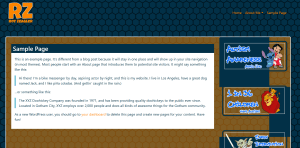Posted on: March 30, 2025
So here’s the deal:
I decided to build a classic WordPress theme from scratch—like the real way. No drag-and-drop builders. No full-site editing wizardry. No bloated templates with ten thousand lines of CSS that nobody asked for. Just me, some code, and a stubborn need for control. 💪 Easy, right? …Right?
I used to build custom WordPress themes back in the day—I’m talking 2007–2010. Back then, we didn’t have Bootstrap (or if we did, I missed the memo). We floated divs, used background images for rounded corners, and prayed to the IE gods that our site wouldn’t explode. Life was simpler. Also slightly terrifying. Coming back to WordPress after all these years felt like opening an old toolbox and realizing someone replaced half the tools with AI-powered robots and the other half with things that yell at you if you don’t use a child theme. So the plan was to build a lightweight, Bootstrap-flavored, classic-style WordPress theme. No block editor, no page builders—just clean PHP templates, SCSS, and full creative freedom. Basically, I wanted to be the theme developer equivalent of someone hand-grinding their coffee beans every morning—except, fun fact: I don’t even drink coffee. 😅
I started with the basics: a style.css file with the theme info block that WordPress treats like a VIP pass. Then I set up functions.php for registering menus, widget areas, and making the site do cool stuff. Standard layout files like index.php, header.php, footer.php, and sidebar.php followed. I even tossed in a screenshot.png that was literally just a gray box because design was… pending. I opened VS Code, cracked my knuckles, and immediately forgot how half of this worked. Back in 2010, I was the framework. Now, I let Bootstrap 5.3 do the heavy lifting—but only through a custom SCSS build, because I like having control over every class, breakpoint, and margin like a true layout goblin. 👹 Of course, I lost a good hour to a broken layout because I forgot to import the grid module. Rookie mistake? Maybe. Classic Roy move? Absolutely.
I also set up multiple widget areas—sidebar-left, sidebar-right, banner-1, feature-1, and footer-1. Everything looked perfect in the code… until one of them flat-out refused to show up. Cue the panic. I rewrote things. I doubted my existence. Eventually, I found the problem—a simple misspelling in the dynamic_sidebar() call. Nothing like a misplaced letter to make you feel like a junior dev again. Shoutout to functions.php for keeping me humble. 🙃 For extra fun, I built a donation form using AJAX—because page reloads are for amateurs. It submitted smoothly, showed a “Thank You” message, and fired off an email like a champ. I was feeling good… right up until I realized I forgot to sanitize the inputs and basically rolled out the welcome mat for hackers. Fixed it, learned the lesson, moved on. I also created custom templates for everything: category archives, full-width pages, my résumé—because if there’s one thing WordPress loves, it’s making you manage 27 template files to show the same post three different ways.
Back in the day, floats and clearfixes were a way of life. You edited core files (don’t judge me), and if your site worked in IE7, you were basically a wizard. These days, it’s all SCSS, Bootstrap, live reloading, and AJAX everything. WordPress now comes with block themes, full-site editing, and a slight identity crisis. I miss the simplicity sometimes… but I also love writing code that doesn’t look like spaghetti.
So what did I learn? Classic theming still slaps if you know what you’re doing—or at least pretend well enough. Bootstrap and SCSS give you serious power, along with a new reason to rage at build errors. WordPress is endlessly flexible… and just as passive-aggressive. And if you used to build themes a decade ago, you can get back into it. Just bring snacks. Would I do it again? Absolutely. Would I do it the exact same way? Not a chance. Would I trade this for a $79 bloated marketplace theme? Not if you paid me. This whole process reminded me why I got into web development in the first place—because making things your way is a good kind of chaos. Next up: maybe block themes. Or maybe setting them on fire. Still deciding. 🔥

Leave a Reply
You must be logged in to post a comment.